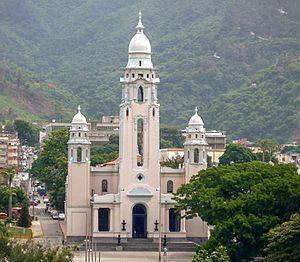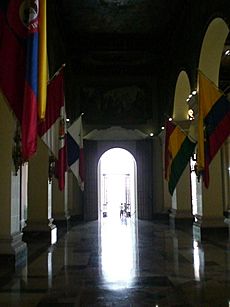National Pantheon of Venezuela facts for kids

National Pantheon of Venezuela
|
|
| Details | |
|---|---|
| Established | 27 March 1874 |
| Location | |
| Country | Venezuela |
| Type | Public |
| Owned by | Venezuelan government |
The National Pantheon of Venezuela (Panteón Nacional de Venezuela) is a special place in Caracas, Venezuela. It's where many of Venezuela's most important national heroes and famous people are laid to rest. Think of it as a grand monument and a cemetery combined, honoring those who shaped the country's history.
This important building was created in the 1870s. It was built on the site of an old church called Santísima Trinidad, which was ruined. The church itself dated back to 1744. The Pantheon is located on the northern edge of the old part of Caracas.
The main part of the Pantheon is dedicated to Simón Bolívar, who is known as the Liberator. He helped several South American countries gain their independence. His bronze sarcophagus, which is like a special coffin, is placed where the church altar used to be. Other important figures are honored in the side areas. The ceiling of the Pantheon is covered with paintings from the 1930s. These paintings show important moments from Bolívar's life. A huge crystal chandelier, a fancy hanging light, was put in place in 1883 to celebrate 100 years since Bolívar's birth. The Pantheon was closed for a few years for big repairs and improvements, and it reopened in 2013.
Contents
Exploring the National Pantheon
The National Pantheon is not just a burial site; it's also a place where you can learn about Venezuelan history. The building itself is impressive, with its grand architecture and the art inside.
Art and Architecture
The Pantheon's design is grand and respectful, fitting for the heroes it honors. The paintings on the ceiling tell stories of the past, especially about Simón Bolívar's journey to free nations. The large chandelier adds to the majestic feel of the place.
Famous Artworks
- Apoteosis del Libertador (Bolívar's Apotheosis) by Tito Salas: This painting shows Bolívar being honored as a hero.
- Bolívar en el Chimborazo (Bolívar on Chimborazo): Another work by Tito Salas, showing Bolívar in a famous moment.
- Entrada triunfal de Bolívar a Caracas después de la Batalla de Carabobo en 1821 (Bolívar's Triumphal Entry into Caracas after the Battle of Carabobo in 1821): This painting captures a key moment in history.
- Foundation of Caracas (1939): This artwork shows the founding of the city.
- 1842 Transfer of the remains of the Liberator from La Guaira to Caracas (1934): This painting depicts the important event of moving Bolívar's remains.
Monuments and Cenotaphs
Inside the Pantheon, you'll find various monuments and cenotaphs. A monument is a statue or structure built to remember someone. A cenotaph is a tomb or monument built to honor someone whose remains are buried somewhere else.
Key Monuments
- Monument to Simón Bolívar by Pietro Tenerani: This is a central and very important statue.
- Monument to José Antonio Páez by José Pizzo: Honoring a key general and first president.
- Monument to José María Vargas by Franco Bianchinni: Remembering a doctor and president.
- Monument to Santiago Mariño by Manuel de la Fuente: Dedicated to another important independence officer.
Important Cenotaphs
- Cenotaph for Francisco de Miranda by Julio Roversi: Miranda was a Venezuelan revolutionary who fought in the American and French Revolutions. His remains have not been found, but he is honored here.
- Cenotaph for Antonio José de Sucre by Juan Bautista Sales Ferré: Sucre was a hero of the South American Independence War and the second President of Bolivia. His empty tomb is kept here, hoping his remains will one day return to Venezuela.
- Cenotaph for Andrés Bello by Manuel de la Fuente: Bello was a famous writer and intellectual.
Who is Honored Here?
The National Pantheon is the final resting place for many people who played a big part in Venezuela's history. They include military leaders, politicians, writers, doctors, and artists.
Notable Figures Buried at the Pantheon
- Simón Bolívar: The most famous person here, known as the Liberator of several South American countries.
- Luisa Cáceres de Arismendi: A brave patriot and heroine of the Venezuelan War of Independence.
- Pedro Camejo: Known as Negro Primero, a hero who fought with Simón Bolívar.
- Teresa Carreño: A world-famous pianist and composer.
- Juan Crisóstomo Falcón: A soldier, politician, and President of Venezuela.
- Rómulo Gallegos: A famous writer and President of Venezuela.
- José Gregorio Monagas: A general and President of Venezuela who ordered the end of slavery in 1854.
- José Antonio Páez: A general and the first president of Venezuela after it separated from Gran Colombia.
- Rafael Rangel: A scientist who studied tropical diseases.
- Simón Rodríguez: Simón Bolívar's teacher and a great thinker.
- José María Vargas: A doctor, surgeon, and President of Venezuela.
- Ezequiel Zamora: A military leader during the Federal War.
Heroes Honored Without Remains
Some heroes are honored with cenotaphs because their remains have not been found, but Venezuelan authorities have declared they should be remembered here.
- Francisco de Miranda: A key leader of Venezuelan Independence.
- Josefa Camejo: A heroine of the Independence War.
- Guaicaipuro: An indigenous chief who bravely fought against the Spanish.
- Manuel Piar: A general-in-chief during the Independence War.
Images for kids
-
Cenotaph of Francisco de Miranda
-
Cenotaph of Antonio José de Sucre
-
Monument to José Antonio Páez
-
Cenotaph of Andrés Bello
-
Monument to José María Vargas
-
Monument to Santiago Mariño
-
Monument to José Gregorio Monagas
See also
 In Spanish: Panteón Nacional de Venezuela para niños
In Spanish: Panteón Nacional de Venezuela para niños















